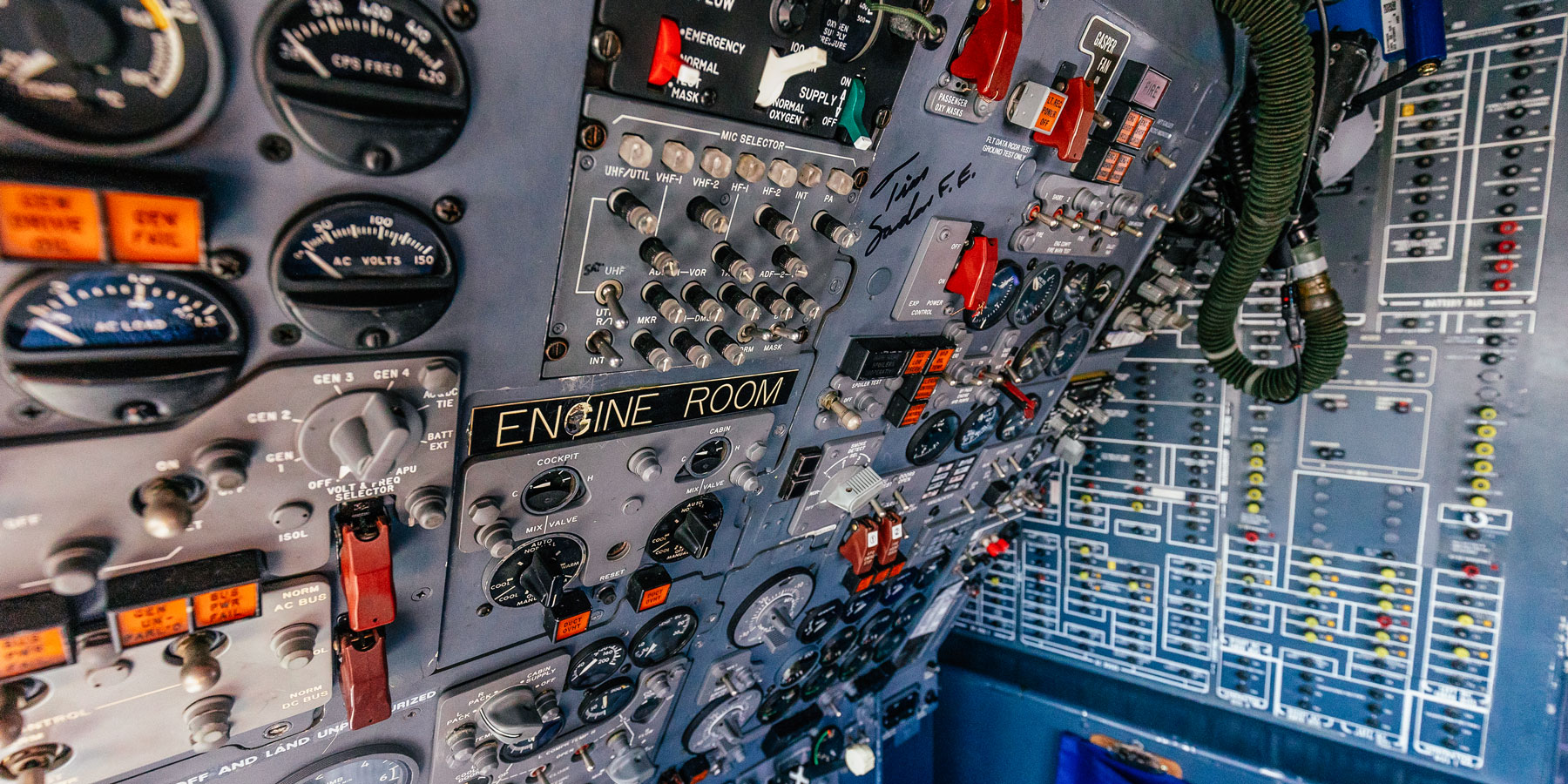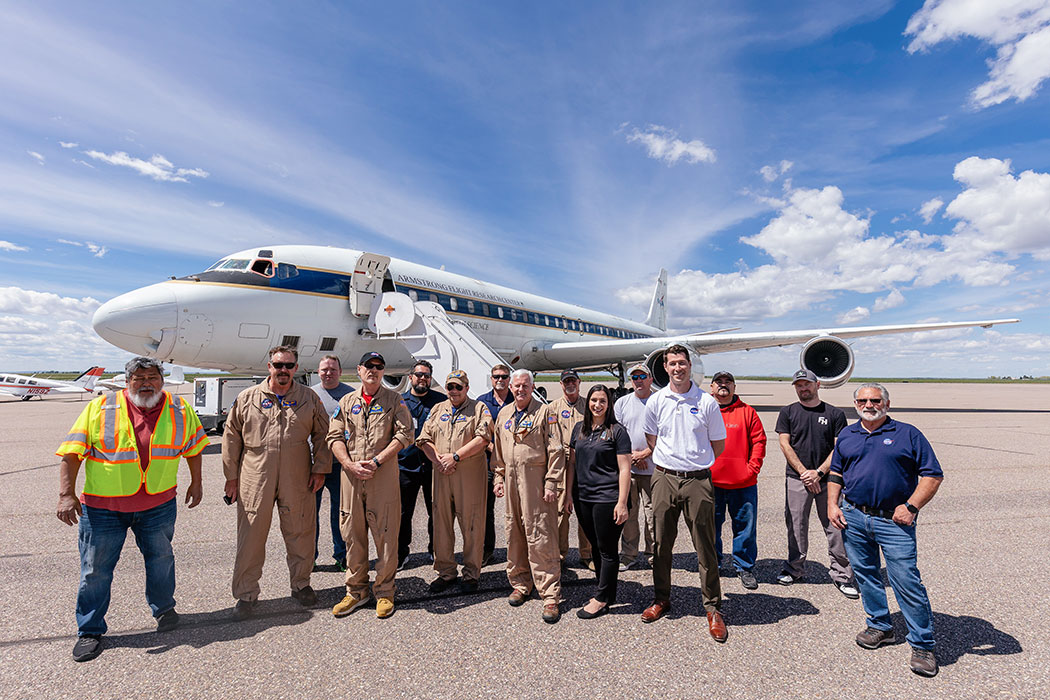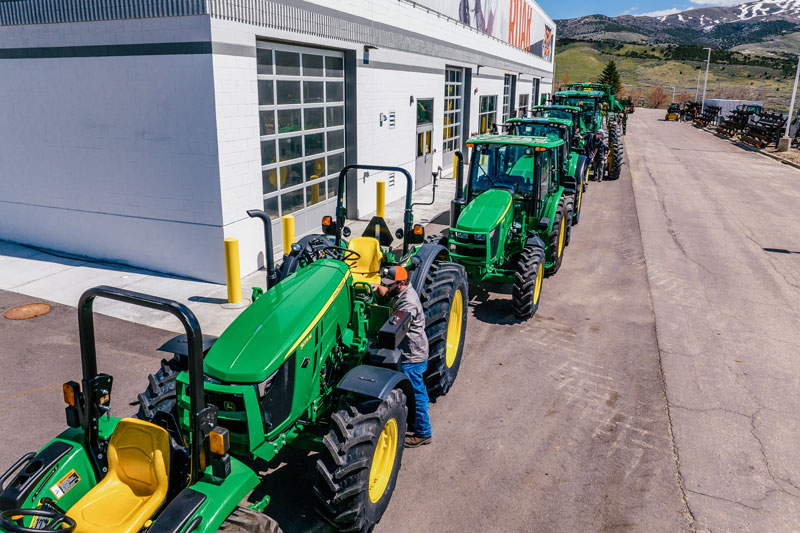Planes, Tractors, and Anatomage Tables
Idaho State Welcomes Technology to Enhance Education

The world’s first and largest flying science laboratory now has a home at Idaho State University.
Thanks to a donation from the federal government, the historic NASA DC-8 aircraft, known for its decades of scientific missions, officially landed at Pocatello Regional Airport on May 15, greeted by ISU officials, community leaders and students from the College of Technology’s aircraft maintenance program.
As the largest flying science laboratory in the world, the DC-8 has been used to support NASA’s Airborne Science mission since 1987. This unique aircraft was first acquired by NASA in 1985 and collected data for experiments in support of scientific projects serving the world’s scientific community – including scientists, researchers, and students from NASA and other federal, state, academic, and foreign institutions.
“I have been lucky enough to work with this amazing team over the last four years, finding ways to help scientists do all kinds of science research. I’ve been fortunate enough to be a part of various science missions, from studying weather and hurricanes in the Virgin Islands to doing air quality research over large cities like New York,” said NASA DC-8 Deputy Project Manager Kirsten Boogaard. “The relationship between NASA and Idaho State University has innovated both research here on Earth, as well as the mission to the moon and beyond. Now, after approximately 150 science missions over 37 years, the DC-8 aircraft is joining the ISU family to train future aircraft technicians.”

Traditionally, an aircraft such as this would be placed in a museum, said Headquarters NASA Product Support Manager Taylor McQuain, but NASA always hopes to repurpose equipment when possible. The aircraft was donated to Idaho State’s Aircraft Maintenance Program by the federal government, and will continue its mission of creating an environment for learning.
“This particular donation benefits future generations in a different way- this way future generations will get hands-on learning,” McQuain said. “It is also unique in that this is believed to be the largest donation that the federal government has given to the state of Idaho.”
College of Technology Dean Jerry Anhorn said the donation will help the University to continue to train highly-skilled technicians ready to meet industry needs.
“The benefits of this donation extend beyond our university. By training highly skilled technicians ready to meet industry needs, we are contributing to a workforce that is versatile, innovative, and, above all, well-prepared,” Anhorn said. “These professionals will go on to ensure the safety and reliability of air travel, to innovate in the fields of aircraft maintenance and aerospace technology.”
The student learning experience for students within the College of Technology has been enhanced by a host of other new equipment as well.

A whole line of the latest John Deere tractors leased to the College of Technology by Stoltz Equipment are utilized by diesel/on-site power generation technology students. A striking lineup of state-of-the-art John Deere tractors highlights the newly expanded diesel/on-site power generation technology facility at the Idaho State University College of Technology. This collection, fondly referred to as the “Green Mile” by instructors, signifies a meaningful collaboration between higher education and local industry.
By leasing an array of advanced tractors to the program, C&B Operations has provided essential resources and helped shape a learning environment reflecting the current technological landscape of the agricultural sector.
"All said, this new equipment is worth nearly $4 million, but C&B Operations leased it to us for basically nothing," said Terro Anderson, program coordinator for the diesel/on-site power generation technology program. The equipment, including models like the S770 combine harvester, R 250 sprayers, and 8400i self-propelled forage harvester, allows students to gain hands-on experience with sophisticated agricultural machinery, enhancing their skills and understanding of modern farming technologies. This partnership not only equips students with valuable skills for the diesel and power generation industries but also strengthens ties between academia and industry, fostering educational and community advancement.
In 2021, the Idaho State University College of Technology received its first simultaneous five-axis computer numerical control (CNC) machine, significantly enhancing the curriculum for the computerized machining technology program. Now, the addition of a second identical machine further boosts the time students can devote to this vital aspect of their studies.
“It really helps with the flow of the program,” said Ashley McCammon, clinical instructor for the program. “With only one, we were limited on the time that the students had which meant less projects and experience on the machine because everyone needed to get on it. Having two we can now give the students more experience running them.”
A simultaneous five-axis CNC machine is a sophisticated piece of equipment used in modern manufacturing that enhances the precision and variety of cuts that can be made on a piece of material. This machine, besides moving along the traditional three axes (X, Y, and Z), introduces two additional axes: the A-axis for tilting and the B-axis for rotation around the workpiece, enabling the creation of complex designs like impellers or propellers. This capability is crucial for producing advanced engineering components with high precision and minimal setup time. With the new machine, students will also be able to undertake more complex projects, challenging their skills and creativity beyond previous limits, thus preparing them for demanding roles in industries such as aerospace and automotive design.
Additional tech now available for students includes:
- New hyper-realistic simulation manikins are benefiting students in health occupations programs such as practical nursing and respiratory therapy.
- A new portable anatomage table that allows students to study all eleven body systems, providing both full-body views and slice views similar to MRI scans.

